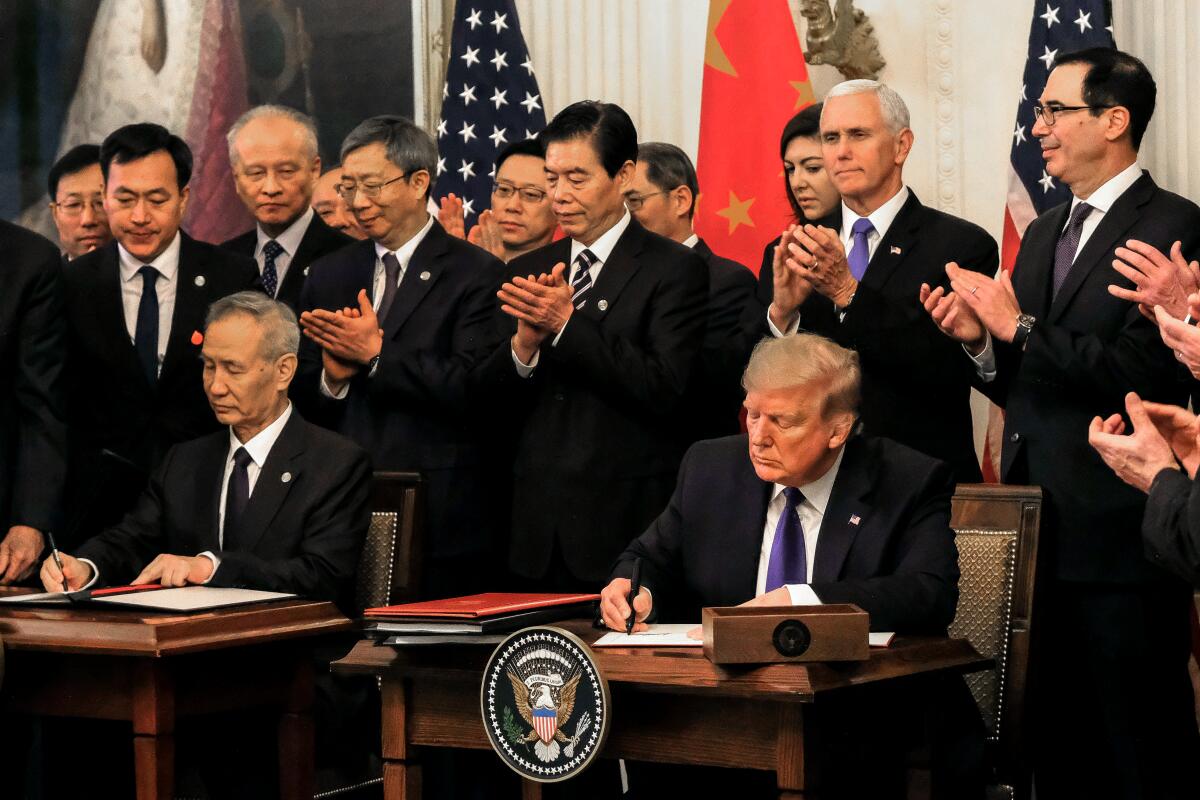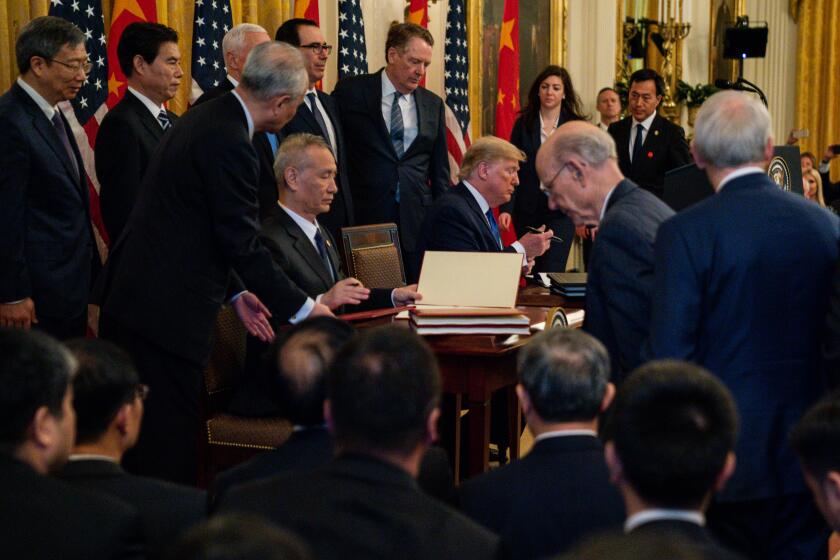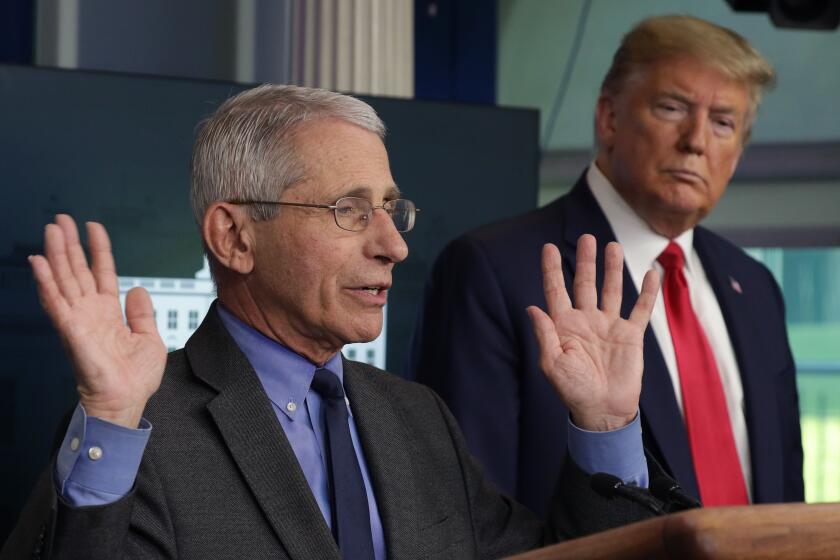Amid coronavirus pandemic, Trump tariffs raise cost of masks, other medical supplies

- Share via
Matt Rowan had a harsh warning for Trump administration trade officials.
Rowan, the CEO of the Health Industry Distributors Assn., which represents middlemen in the global trade of medical masks, gowns, ventilators and other supplies and equipment, cautioned that Trump’s trade war with China would erode America’s ability to acquire those crucial products.
“With infection protection as a key initiative throughout healthcare, usage of these products should be encouraged, not inhibited by tariff-associated cost increases or disruptions,” Rowan said. He forecast “product shortage” and limits on “the ability of all levels of government...to adequately support response efforts during emergency events.”
No other country individually or in combination has close to the manufacturing capacity to replace what we get from China....There are not alternative manufacturing facilities.
— Linda Rouse O’Neill, Health Industry Distributors Assn., in June 2019
That was on Aug. 20, 2018, just before the administration was preparing to launch a trade war with tariffs of up to 25% on products from China, including healthcare supplies.
Rowan’s example of a public health emergency was not today’s coronavirus, which was unknown at the time, but the Ebola virus, which was then experiencing a resurgence in Africa.
The China tariffs were imposed anyway. The Trump White House didn’t lift them on desperately needed healthcare supplies until last month. But it has left in place previously imposed tariffs on many of these products, regardless of their nation of origin.
To this day, the highest-quality and most sought-after N95 masks still carry a 7% tariff. The levies on other medical headwear are as much as 8.3% and on medical gowns and other protective clothing 4.5%.
“Starting in the summer of 2018, you had the medical community come forward and say, ‘Don’t put tariffs on these products, because they’re going to hurt preparedness for a pandemic,’” says Chad P. Bown of the Peterson Institute for International Economics, who has been following the trade war.
“They didn’t have COVID-19 in mind, but they had Ebola in mind, they had H1N1 [flu] in mind, and they spelled out this problem when it comes to medical equipment.”
Here’s what a hospital chain went through to get a supply of coronavirus masks
Often, tariffs are imposed to protect domestic manufacturers from low-priced foreign competitors. That wasn’t the case with the tariffs on medical products, which have been sourced from overseas for decades; even domestic manufacturers such as 3M, which produces N95 masks, make them in factories in China and other offshore locations.
The main purpose of Trump’s tariffs is punitive — to force China to the table on non-tariff trade barriers such as protecting intellectual property. But the deteriorating trade relationship between two countries that had become leading customers of each other has worked against the U.S. in the competitive market for life-saving medical gear.
“The main source of imports of these products for anybody around the world is China,” Bown told me. “Now, if you’re trying to place orders in China, which is getting the same orders from all over the world, the United States does not look like the most reliable customer.”
Trump’s repeated assertion that China pays the tariffs he’s imposed is simply wrong. They’re paid by importers, who pass them on to their own customers, chiefly hospitals. So the tariffs not only interfere with the supply chain for medical supplies, but strain the budgets of healthcare providers.
Hiltzik: Nurses know we were unprepared for the coronavirus. They’re being punished for speaking out
Nurses know how unprepared we were for COVID-19. They’re getting punished for speaking out.
Rowan covered that, too: “Tariffs on healthcare products will ultimately drive up healthcare costs for every American,” he said at the August 2018 hearing. That warning also fell on deaf ears.
The distributors association says that the tariffs in and of themselves haven’t affected the availability of critically needed supplies in the current emergency, but they have made them more expensive.
“When you’re looking at products that are fairly commoditized and low-margin” such as masks and disposable gowns, says Linda Rouse O’Neill, the association’s vice president for government affairs, “adding costs is not helpful to having a robust industry.”
Shortages of medical supplies caused by a spike in demand during the coronavirus crisis have prompted many users to take extraordinary measures and pay extraordinary prices for products they used to stock routinely. Sometimes, as I reported recently, they’ve even had to stage cloak-and-dagger operations to secure supplies and keep them out of others’ hands.
The reckless inconsistencies of the tariff war parallel the lack of planning and care underlying a huge proportion of Trump policies.
President Trump has declared victory in the trade war with China -- but America has paid all the price.
As Bown observed in an analysis last month, America imported about $22 billion of disposable equipment such as masks and hospital gowns and high-tech equipment such as CT, ultrasound and X-ray machines in 2019.
“Before Trump began the trade war in 2018, U.S. tariffs on imports of most of these products were fairly low,” Bown reported. “For half of the products imported, the U.S. tariff was even zero. A handful faced nuisance tariffs of less than 4.5%, and disposable and other medical headwear had tariffs of 6% to 8%.”
About a fourth of these products, or $5 billion in imports, came from China. Once the trade war started, the import flow shut down. The import growth rate of products subject to the stiffest 25% tariffs, including CT systems, thermometers and disposable headgear, fell by as much as 64% from mid-2018 to mid-2019.
Imports from the rest of the world grew faster, but not always by enough to fully compensate for the slowdown from China. Growth in imports of products subject to tariffs of only 15% also slowed, though by not as much.
As part of its “phase 1” trade deal with China in January, Trump cut the 15% tariffs in half, to 7.5%, as of early February. The dime finally dropped for the Trump administration as of March 17, when some medical supplies were excluded from the 7.5% China tariffs.
Now Trump is blaming the NIH for his coronavirus fiasco.
But some are still subject to pre-Trump tariffs, including the 7% levy on masks. Trump could exempt them from non-China tariffs, but hasn’t done so.
In any event, much of the damage to the supply chain had been done by the time the administration acted on the China tariffs. If trade officials were expecting that American distributors would simply shift purchases to non-China sources, they were living a pipe dream.
As O’Neill testified in June, for many products “no other country individually or in combination has close to the manufacturing capacity to replace what we get from China....Gloves especially are almost 100% manufactured in China. The same is true for some of the other personal protective equipment like gowns. There are not alternative manufacturing facilities.”
Because U.S. regulations require new manufacturing sources to be approved, “it takes months, if not years, to set up any sort of separate shop.”
Trump has tried to compensate for the dearth of supplies coming in from overseas by imposing export restrictions on American-made products to husband domestic supplies. That might even exacerbate the problem, Bown argues, since the U.S. is a net importer of these products, buying five times as much from abroad as it sells abroad.
“U.S. trading partners will not sit idly by in response,” Bown predicts, noting that the administration’s confidence that the earlier rounds in its trade war administration wouldn’t result in countermeasures was not borne out.
After trade advisor Peter Navarro stated in 2018 that no country would retaliate for Trump’s tariffs on aluminum and steel, Bown observes, “It turns out almost every major U.S. trading partner retaliated.”
The threat to U.S. supplies is serious. “Today, foreign governments could also cut off American access to other PPE, such as face shields, goggles, and hospital gowns, as well as ventilators, catheters, X-ray equipment, or CT scanners,” Bown observed. “To paraphrase President Trump, trade wars in medical gear are easy to lose. The human costs could be devastating.”
More to Read
Inside the business of entertainment
The Wide Shot brings you news, analysis and insights on everything from streaming wars to production — and what it all means for the future.
You may occasionally receive promotional content from the Los Angeles Times.














